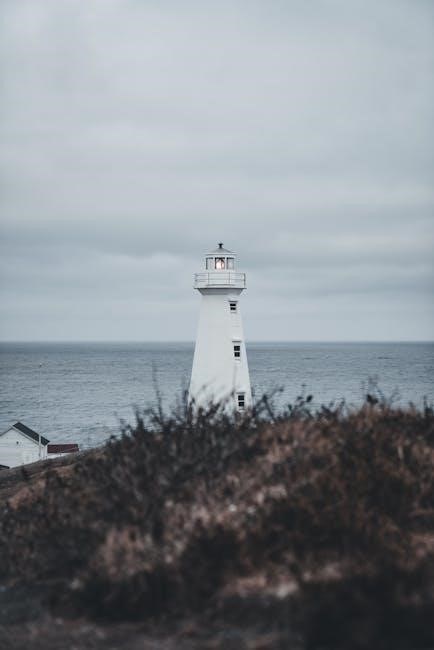Anchor Guide: A Comprehensive Overview
Embark on a journey into the world of boat anchors. From their evolution from simple rocks to the diverse designs of today‚ understanding anchors is vital. This guide offers valuable insights for boaters of all levels to ensure your vessel stays secure.
Understanding Boat Anchor Basics
Anchoring is a fundamental skill for any boater‚ be it on a pontoon‚ sailboat‚ or any other vessel. It’s essential for securing your boat. An anchor’s primary function is to hold a vessel in place‚ resisting the forces of wind and current. Without the right anchor‚ you’re at the mercy of the elements.
Anchors come in various shapes and sizes‚ each designed for specific conditions and boat types. Choosing the correct anchor ensures safety and peace of mind. A basic understanding of anchor components and how they interact with the seabed is crucial. The anchor‚ chain‚ and rope (together known as the rode) work in unison to provide holding power.
Selecting the right anchor involves considering factors like boat size‚ displacement‚ and anticipated weather conditions. A “lunch hook” is suitable for calm conditions‚ while a working anchor is necessary for stronger winds. Always prioritize safety by selecting an anchor that exceeds minimum requirements‚ providing a margin of error in challenging situations.
Types of Boat Anchors and Their Uses
The market offers a plethora of boat anchors‚ each designed for specific bottom types and boating needs. Understanding the characteristics of each type is key to selecting the right one; Fluke anchors‚ like the Danforth‚ excel in mud and sand‚ offering excellent holding power for their weight. Plow anchors‚ such as the CQR‚ are versatile and perform well in various bottom conditions‚ including grass and rock.
Mushroom anchors are ideal for mooring buoys and small boats in soft mud. Grapnel anchors‚ with their multiple tines‚ are suitable for rocky bottoms but can be challenging to retrieve if snagged. Box anchors are known for their exceptional holding power and are often used in challenging conditions. Each anchor type has its strengths and weaknesses.
Choosing the right anchor depends on the type of boating you do and the areas you frequent. Consider the prevailing bottom conditions and typical weather. Having a secondary anchor is wise in case of emergencies or when anchoring in uncertain environments. Proper anchor selection ensures your boat stays securely moored‚ providing peace of mind.
Anchor Materials: A Comparison

Boat anchors are commonly constructed from various materials‚ each offering distinct advantages and disadvantages. The most prevalent materials include galvanized steel‚ stainless steel‚ and aluminum. Galvanized steel anchors are popular due to their affordability and resistance to corrosion‚ providing a cost-effective solution for many boaters. However‚ the galvanization can wear off over time‚ requiring periodic re-galvanizing.
Stainless steel anchors offer superior corrosion resistance‚ making them ideal for saltwater environments. Their sleek appearance and durability make them a premium choice‚ though they come at a higher price point. Aluminum anchors are lightweight‚ making them suitable for smaller boats and situations where weight is a concern. While aluminum resists corrosion well‚ it is generally less strong than steel.
The choice of anchor material depends on your budget‚ boating environment‚ and the size of your boat. Consider the trade-offs between cost‚ durability‚ and weight. Regular inspection and maintenance are crucial‚ regardless of the material chosen‚ to ensure the anchor remains in optimal condition for reliable performance.
Anchor Size and Weight Guide
Selecting the right anchor size and weight is crucial for ensuring your boat’s safety and security when anchoring. An undersized anchor may drag‚ while an oversized anchor can be difficult to handle. Several factors influence the appropriate anchor size‚ including your boat’s length‚ displacement‚ and typical boating conditions.
Generally‚ manufacturers provide anchor size charts based on boat length. However‚ it’s wise to consider your boat’s displacement‚ which refers to its weight. Heavier boats require larger anchors. Additionally‚ if you frequently boat in areas with strong winds‚ currents‚ or poor holding bottoms‚ it’s advisable to upgrade to the next size.
Lewmar and other manufacturers offer guidelines that consider both length and displacement. When in doubt‚ err on the side of caution and choose a slightly larger anchor. Consulting these charts is a good starting point‚ but always assess your specific needs and boating conditions. Remember‚ the safety of your vessel depends on a properly sized and weighted anchor.
Essential Anchoring Techniques
Mastering essential anchoring techniques is paramount for safe and secure boating. Anchoring isn’t just about dropping the anchor; it involves a series of steps to ensure it sets properly and holds reliably. Begin by selecting an appropriate anchorage‚ considering factors like depth‚ bottom composition‚ and potential hazards.
Before dropping anchor‚ assess the wind and current direction to determine how your boat will drift. Slowly motor into the wind or current and gradually lower the anchor‚ paying out sufficient rode (anchor line or chain). A general rule of thumb is to use a rode length of at least 5:1 or 7:1 scope‚ meaning the ratio of rode length to water depth.
Once the anchor is on the bottom‚ slowly motor astern to set it firmly. Observe your boat’s position and use landmarks or GPS to confirm that the anchor is holding. If the anchor drags‚ retrieve it and try again in a slightly different location. Regularly check your anchor’s position and condition‚ especially during changing weather conditions. By following these essential techniques‚ you can anchor with confidence and enjoy your time on the water.
Anchor Rode: Chain and Rope Considerations

The anchor rode‚ the connection between your boat and the anchor‚ is a crucial component of the anchoring system. Choosing the right rode material and length is essential for reliable anchoring. The rode typically consists of a combination of chain and rope‚ each offering distinct advantages.
Chain provides excellent weight and abrasion resistance‚ helping the anchor to set quickly and stay firmly planted on the seabed. It also resists chafe from rocks or coral. Rope‚ on the other hand‚ is lighter and more elastic‚ absorbing shock loads from waves and wind gusts. Nylon rope is a popular choice due to its strength and stretch.
The ideal rode configuration depends on your boat size‚ anchoring conditions‚ and personal preferences. A common setup involves a length of chain close to the anchor‚ followed by rope. The chain length should be sufficient to keep the rode near the seabed‚ maximizing holding power; Ensure that the rope and chain are properly spliced or connected with shackles to prevent separation. Regularly inspect your rode for wear and tear‚ replacing it as needed to maintain its integrity.
Anchor Rollers: Functionality and Benefits
Anchor rollers are essential pieces of equipment that facilitate the smooth and controlled deployment and retrieval of your anchor. Mounted on the bow of the boat‚ they serve as a guide for the anchor rode‚ reducing friction and preventing damage to the hull. Their functionality extends beyond mere convenience‚ contributing significantly to boating safety and efficiency.
One of the primary benefits of anchor rollers is the ease of handling they provide. Hauling a heavy anchor by hand can be strenuous and even dangerous‚ especially in rough conditions. Anchor rollers allow you to retrieve the anchor with minimal effort‚ often in conjunction with a windlass. They also ensure that the anchor is properly stowed‚ preventing it from swinging freely and potentially damaging the boat.
Furthermore‚ anchor rollers protect the boat’s hull from scratches and dents caused by the anchor chain or shank. The roller’s smooth surface allows the anchor to glide effortlessly over the bow‚ preventing direct contact with the gel coat. Selecting the right anchor roller depends on your anchor type and boat design. Consider features like self-launching mechanisms and sturdy construction for optimal performance.

Anchoring in Different Conditions
Successfully anchoring your boat requires adapting your technique to the prevailing conditions. Wind speed‚ current‚ and bottom type all play a crucial role in determining the best anchoring strategy. Understanding how these factors interact will significantly improve your anchoring success and safety.
In calm conditions with a sandy bottom‚ a single anchor with a scope of 5:1 (rode length to depth) is usually sufficient. However‚ when facing strong winds or currents‚ increasing the scope to 7:1 or even 10:1 is recommended. For challenging bottoms like rock or weed‚ consider using a specialized anchor designed for those conditions.
Muddy bottoms can be tricky‚ as anchors may sink deeply and become difficult to retrieve. Using a larger anchor or deploying a second anchor in tandem can provide additional holding power. When anchoring in areas with significant tidal changes‚ be sure to account for the increased depth at high tide. Finally‚ always be mindful of other boats and obstructions in the anchorage to avoid collisions or fouled anchors. By adapting your anchoring technique to the specific conditions‚ you can ensure a safe and enjoyable experience on the water.
Troubleshooting Common Anchoring Problems
Even with the best equipment and technique‚ anchoring problems can arise. One common issue is anchor dragging‚ often caused by insufficient scope‚ strong winds‚ or an unsuitable anchor for the bottom type. If your anchor drags‚ immediately increase the scope or consider deploying a second anchor.

Another frequent problem is a fouled anchor‚ where the anchor becomes entangled with rocks‚ weeds‚ or other obstructions. Attempt to motor around the anchor in a wide circle to try and dislodge it. If this fails‚ a dedicated anchor retrieval system or even a professional diver may be required.
Chafing of the anchor rode is also a concern‚ especially in rough conditions. Regularly inspect the rode for wear and tear‚ and use chafing gear to protect it from sharp edges. A noisy anchor chain can be disruptive‚ especially at night. Consider using a chain snubber to reduce noise and absorb shock loads. Finally‚ always be prepared for unexpected changes in weather or current‚ and be ready to adjust your anchoring strategy accordingly. By anticipating and addressing these common problems‚ you can minimize frustration and ensure a safe and secure anchoring experience.
